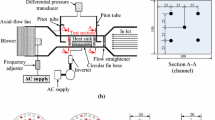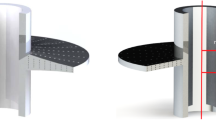Abstract
The present work aims to investigate the heat transfer characteristics of heated cylindrical pins within an air-filled rectangular enclosure experimentally in a natural convection dominated regime. The experiments are performed to analyze the effects of fin spacing (25 mm ≤ S ≤ 100 mm) and Rayleigh number (248,659 ≤ Ra ≤ 578,395) as key factors at constant pin height (l = 25 mm) and pin diameter (d = 10 mm) values. The results confirm the existence of optimum fin spacing providing maximum heat transfer enhancement. The investigation is extended further to quantify the effects of the presence of cylindrical porous pins with the uniform diameter (dp = 15 mm), pin length (lp = 20 mm) and calculated porosity of 19.3% by volume on the thermal performance of the system. The results reveal the improved system performance due to the presence of a porous medium for all tested system configurations. Some new empirical correlations predicting system performance are also proposed those demonstrate the satisfactory qualitative behavior of system performance.











Similar content being viewed by others
Abbreviations
- A :
-
Area (m2)
- AR :
-
Aspect ratio
- a :
-
enclosure length (m)
- b :
-
enclosure width (m)
- d :
-
pin diameter (m)
- Da :
-
Darcy number
- F′ :
-
shape factor
- g :
-
acceleration due to gravity (m/s2)
- Gr :
-
Grashof number
- H :
-
enclosure height (m)
- h :
-
Convection heat transfer coefficient (W/m2-K)
- HC:
-
Half cylinder
- k :
-
thermal conductivity (W/m-K)
- K p :
-
Permeability (m2)
- l :
-
pin length (m)
- m :
-
mass flow rate (kg/s)
- Nu :
-
Nusselt number
- O :
-
Porous medium’s orientation
- Pr:
-
Prandtl number
- Q :
-
heat transfer rate (W)
- R :
-
Resistance of the panel heater (Ω)
- Ra :
-
Rayleigh number
- Re :
-
Reynolds number
- S :
-
Longitudinal fin spacing (m)
- T :
-
Temperature (K)
- V :
-
voltage applied (V)
- v :
-
volume (m3)
- x :
-
Enclosure wall thickness (m)
- y :
-
Lateral fin spacing (m)
- z :
-
Average air gap between contact surfaces (m)
- β :
-
Coefficient of volume expansion (K−1)
- ε’ :
-
emissivity
- ν:
-
kinematic viscosity (m2/s)
- σ :
-
Stefan Boltzmann constant (W/m2-K4)
- φ :
-
porosity
- χ :
-
Performance ratio
- δ :
-
Base plate thickness (m)
- a :
-
Air
- c :
-
cold surface
- f :
-
film
- h :
-
hot surface
- w :
-
wall
- r :
-
radiating surfaces
- p :
-
porous
- t :
-
total
- ch :
-
characteristic
References
Banerjee S, Mukhopadhyay A, Sen S, Ganguly R (2008) Natural convection in a bi-heater configuration of passive electronic cooling. Int J Therm Sci 47:1516–1527
Basak T, Ayappa KG (2001) Influence of internal convection during microwave thawing of cylinders. AICHE J 47:35–850
Lin YJP, Xu ZY (2013) Buoyancy-driven flows by a heat source at different levels. Int J Heat Mass Transf 58:312–321
Celentano D, Cruchaga M, Moraga N, Fuentes J (2001) Modelling natural convection with solidification in mould cavities. Numer Heat Transf A 39:631–654
Wang SM, Faghri A, Bergman TL (2010) A comprehensive numerical model for melting with natural convection. Int J Heat Mass Transf 53:1986–2000
Khaled ARA, Vafai K (2003) The role of porous media in modeling flow and heat transfer in biological tissues. Int J Heat Mass Transf 46:4989–5003
Weir GJ (1994) The relative importance of convective and conductive effects in two-phase geothermal fields. Transp Porous Media 16:289–298
Ndao S, Peles Y, Jensen MK (2014) Effects of pin fin shape and configuration on the single-phase heat transfer characteristics of jet impingement on micro pin fins. Int J Heat Mass Transf 70:856–863
Kadam ST, Kumar R (2014) Twenty first century cooling solution: microchannel heat sinks. Int J Therm Sci 85:73–92
Kheirabadi AC, Groulx D (2016) Cooling of server electronics: a design review of existing technology. Appl Therm Eng 105:622–638
Geetha NB, Velraj R (2012) Passive cooling methods for energy efficient buildings with and without thermal energy storage – a review. Energ Educ Sci Technol A Energ Sci Res 29:913–946
Pacheco R, Ordóñez J, Martínez G (2012) Energy efficient design of building: a review. Renew Sust Energ Rev 16:3559–3573
Webb RL (1987) Enhancement of single-phase heat transfer. In: Kakac S, Ramesh KS, Aung W (eds) Handbook of single-phase convective heat exchanger design. Wiley, New York
Peng Y (1984) Heat transfer and friction loss characteristics of pin fin cooling configurations. J Eng Gas Turbines Power 106:246–251
Brigham BA, Van Fossen GJ (1984) Length to diameter ratio and row number effects in short pin fin heat transfer. J Eng Gas Turbines Power 106:241–245
Norris RH, Spofford WA (1942) High-performance fins for heat transfer. Trans ASME 64:489–496
Tanda G (2001) Heat transfer and pressure drop in a rectangular channel with diamond shaped elements. Int J Heat Mass Transf 44:3529–3541
Armstrong J, Winstanely D (1988) A review of staggered array pin fin heat transfer for turbine cooling applications. J Turbomach 110:94–103
Arshad A, Muhammad Ali H, Khushnood S, Jabbal M (2018) Experimental investigation of PCM based round pin-fin heat sinks for thermal management of electronics: effect of pin-fin diameter. Int J Heat Mass Transf 117:861–872
Eren M, Caliskan S (2016) Effect of grooved pin-fins in a rectangular channel on heat transfer augmentation and friction factor using Taguchi method. Int J Heat Mass Transf 102:1108–1122
Zografos AI, Sunderland JE (1990) Natural convection from pin fins. Exp Thermal Fluid Sci 3:440–449
Zografos AI, Sunderland JE (1990) Numerical simulation of natural convection from pin–fin arrays. ASME HTD 157:55–66
Sparrow E, Vemuri S (1985) Natural convection/radiation heat transfer from highly populated pin-fin arrays. Int J Heat Mass Transf 107:190–197
Sparrow E, Vemuri S (1986) Orientation effect on natural convection/radiation heat transfer from pin-fin arrays. Int J Heat Mass Transf 29(3):359–368
Hsu H-J, Huang Y-H, Liu Y-H (2016) Natural convection in an oscillating cylindrical enclosure with pin fins. Int J Heat Mass Transf 93:720–728
Micheli L, Reddy KS, Mallick TK (2016) Experimental comparison of micro-scaled plate-fins and pin-fins under natural convection. Int Commun Heat Mass Transf 75:59–66
Rashidi S, Esfahani JA, Rashidi A (2017) A review on the applications of porous materials in solar energy systems. Renew Sust Energ Rev 73:1198–1210
Salman ANJ, Sarfaraz K, Badruddin IA, Abdullah AAAA, Quadir GA, Khaleed HMT, Khan YTM (2014) Conjugate heat transfer in porous annulus. J Porous Media 17:1109–1119
Bürger M, Buck M, Pohlner G, Rahman S, Kulenovic R, Fichot F, Ma WM, Miettinen J, Lindholm I, Atkhen K (2010) Coolability of particulate beds in severe accidents: status and remaining uncertainties. Prog Nucl Energy 52:61–75
Varol Y (2011) Natural convection in porous triangular enclosure with a centered conducting body. Int Commun Heat Mass Transf 38:368–376
Nield DA, Bejan A (2013) Convection in porous media. In: Jansen JD (ed) A systems description of flow through porous media. Springer, New York
Badruddin IA, Salman ANJ, Abdullah AAAA, Nik-Ghazali N, Mohammed J, Sarfaraz K, Khaleed HMT, Khan TMY (2015) Conjugate heat transfer in an annulus with porous medium fixed between solids. Transp Porous Media 109(3):589–608
Oztop HF (2007) Natural convection in partially cooled and inclined porous rectangular enclosures. Int J Therm Sci 46:149–156
Bashi M, Rashidi S, Esfahani JA (2017) Exergy analysis for a plate-fin triangular duct enhanced by a porous material. Appl Therm Eng 110:1448–1461
Bhuiyan AA, Banna MH, Barna SF, Ruhul Amin M, Sadrul Islam AKM (2016) Numerical modelling of thermal characteristics in a microstructure filled porous cavity with mixed convection. Int J Heat Mass Transf 93:464–476
Mojumder S, Saha S, Rahman MR, Rahman MM, Rabbi KM, Ibrahim TA (2017) Numerical study on mixed convection heat transfer in a porous L-shaped cavity. Eng Sci Technol Int J 20:272–282
Dwivedi A, Das D (2017) Experimental investigation for the performance of triangular fin array within a rectangular enclosure in natural convection dominated region. Heat Mass Transf 53:1933–1942
Ellison GN (1979) Generalized computations of the gray body shape factor for thermal radiation from a rectangular U-channel. IEEE Trans Compon Hybrids Manuf Technol 2:517–522
Incropera F, DeWitt D (1996) Introduction to heat transfer. Wiley, New York
Suryanarayana NV (1995) Engineering heat transfer. West Publishing Company, New York
Dullien F (1992) Porous media: fluid transport and pore structure. Academic Press, San Diego
Holman JP (1989) Experimental methods for engineers. McGraw-Hill, Singapore
Jakob M (1946) Free heat convection through enclosed plane gas layers. J Heat Transf 68:189–193
Sahray D, Magril R, Dubovsky V, Gennady Z, Letan R (2006) Natural convection heat transfer from pin fin heat sinks with horizontal base. Proc 13th Int heat Transf Conf, Sydney, Australia
Saini S, Saini R (2008) Development of correlations for Nusselt number and friction factor for solar air heater with roughened duct having arc-shaped wire as artificial roughness. Sol Energy 82:1118–1130
Verma SP, Das D (2018) Analysis of natural convection heat transfer through staggered pin finned horizontal base plate within a rectangular enclosure. Heat Mass Transf 54(9):2635–2644
Author information
Authors and Affiliations
Corresponding author
Additional information
Publisher’s note
Springer Nature remains neutral with regard to jurisdictional claims in published maps and institutional affiliations.
Rights and permissions
About this article
Cite this article
Das, D., Singapuri, C. & Dwivedi, A. Experimental determination of buoyancy induced convection heat transfer characteristics in a rectangular cavity with cylindrical porous medium fixed between pin fins. Heat Mass Transfer 56, 1293–1306 (2020). https://doi.org/10.1007/s00231-019-02767-y
Received:
Accepted:
Published:
Issue Date:
DOI: https://doi.org/10.1007/s00231-019-02767-y






